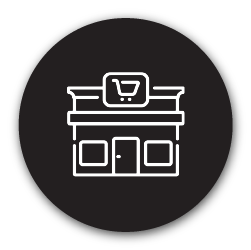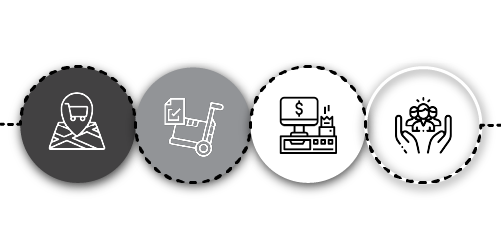Managing or opening a store is never an easy task. We know that because we've played a direct hand in many new store openings. You know that because you've likely completed a few yourself. Then there is the managing of that new store. We're sure you'll agree - any task around store operations* is challenging. That’s especially true if you don’t have all the necessary elements.
There are many different aspects to ensure successful store operations that need your attention. You must manage all these working parts equally well.
It makes it that much more difficult when you consider retail is an ever-changing industry. You only need to consider the impact that the COVID-19 pandemic has had on how people shop. According to IBM’s U.S. Retail Index, the pandemic has accelerated the shift to e-commerce by five years.
Fortunately, it’s not all doom and gloom. Customers are returning to stores and shopping in person. However, the point remains: you need to up your game if you want them to continue visiting your store.

What do we mean by store operations?
Before we look at all the elements, you need to see short- and long-term success as a retailer, it’s critical to explain what we mean by store operations.
Store operations refer to the business of managing the various components that make up your retail store in an effort to ensure it functions optimally at all times.
These components are various, and we’ll touch on many of them in this article. But you can also understand them in the form of a few questions. The below are not an exhaustive list, but it can point you in the right direction. They include:
- What location do you choose for your store?
- Why are you locating your store in a particular area?
- How will you layout your store?
- How will the exterior of your store look?
- What type of inventory do you plan to sell?
- How do you plan on pricing the inventory you stock?
- What plans do you have to maintain or improve the shopping experience?
- What level of customer service do you plan to offer?
The above is only a fraction of the questions you can ask yourself (and your store) to set up short- and long-term success.
If you’re unsure about what to tackle, here’s a simple way of knowing: If the action you need to take influences how you run your store, you must have control of it.
 Unpacking the critical elements of store operations success
Unpacking the critical elements of store operations success
The below elements are all critical for your success as a retailer. But we’d like to add a caveat. We haven’t listed these elements in order of importance.
Why? It’s simple because all of these are critical. They also feed into each other.
We might be jumping the gun a little, but here’s an example.
You might have the right inventory to meet your target market. You might also have the best customer service around to match it. However, if your store is not in the right location, you’ll struggle to survive.
1. Choose the right store location
We've just mentioned the importance of choosing the right location for your store, so we'll start with that element first.
What is that saying? Location, Location, Location? Yes, it’s a cliché but it’s right, especially when it concerns retail.
However, to run a successful business, you need to consider your physical store too.
And when considering your store, you must ask this question:
Where should you locate your store?
It’s not as simple as finding a locale that draws a lot of foot traffic. If only it were that easy.
Instead, there are many different factors to consider. It includes the type of goods you plan to sell (which we speak about in more depth below) and your target market. Who do you plan on selling to?
Imagine this: you locate your store in an LSM 1-4 area but you sell products that are better suited to an LSM 9-10 market. Or, you locate your store alongside a category specialist retailer when you only stock a convenience range. Both decisions can have disastrous consequences for your business.
There are also your store hours.
If you’re based in a shopping centre, you’ll need to conform to their operating hours. Meanwhile, if you’re an independent retailer, you can choose your opening hours. What do your intended customers expect and how do they shop? If they’re looking to pick up items after work hours, it might be better to locate your store in an area where it allows you to remain open later.
And then there are your security measures. What do you need to have in place to secure your premises and the products you sell? It differs according to your size and the products you sell.
For example, if you have a large store, security cameras placed in strategic areas and security tags on your products could be necessary. With a small store, you might not even need a security camera. Either way, the last thing you want after opening a store is inventory shrinkage because of theft.
2. Choose and manage your inventory appropriately
Now that you’ve chosen your location and you’re satisfied it's the best spot to grow your business, it comes down to the question of what products you want to stock.
It’s about allocating the right type of merchandise to your store so that you can ensure you meet the needs (and demands) of anyone who visits your store. And not just once, but continuously so.
You only need to look at what happens if you don’t get this right. We’ve written about the consequences that arise due to overstocking your store or running out of stock. They’re all devastating. We’ve also written about how you can ensure you get it right: localise your assortment planning.
That said, it’s not only about choosing the right type of merchandise for your store. You also need to present your products in a way that encourages shoppers to want to buy them. People buy with their eyes first and so you need to appeal to this sense, after all.
For this, there are various merchandising techniques you can consider. There are also different retail displays and fixtures you can use.
When deciding on your merchandising techniques and retail fixtures, always consider the products you stock. Choosing the wrong technique or fixture for products will negatively impact your bottom line.
There is the point that your overall retail strategy also plays a role in how you offer your products.
If you want to give all of your products equal visibility, vertical merchandising might be right for you. On the other hand, if you’re moving to entice your customers to shop your entire store, horizontal merchandising might be more appropriate.
Of course, when considering how to manage your inventory, you do need to look at your store and shelf space. The last thing you’d want are shelves that are so highly congested that your store would appear messy. But, you also don’t want to waste store space by not using it appropriately.
3. Choose a POS system that suits your business
It’s all good and well, having the right merchandising techniques and fixtures in place. But how are you going to actually record the number of sales you have made and, in so doing, predict what you plan to make in the future?
That’s the underlying question for this next step.
Point of sales data is the starting point for any other data you collect. It’s thus vital that you have a POS system in place that suits your business needs.
Fortunately, there are many different POS system options available to you. In reality, it’s a flooded market - type ‘POS System’ into your favourite search engine and you’ll receive over three billion hits in less than a second. ‘Point of Sales System’ gets over six billion hits.
This means you’ll be able to find one that suits your business and your budget.
It doesn’t matter if you’re a small retailer with a tight budget or a large chain for whom money isn’t an issue. There is a POS system out there that will suit all of your needs.
Are you looking for a POS system for your business? Here are a few questions to ask, courtesy of point-of-sale and e-commerce software provider, Lightspeed:
- How does the POS system sync your online and retail store?
- Does the POS system empower your staff?
- Does the POS system offer reporting and analytics?
- Can the POS system support your business growth?
With the right POS system in place, you can understand what your customers are buying, which can help you supplement any other decisions. That includes stocking more of your popular products and less of those not selling as well as you had hoped.
4. Focus on the right kind of customer service
If you’re hoping to achieve retail success, you need to encourage shoppers to visit your store. That must is a given. But you also need to entice them to return again and again.
One way of ensuring that is by providing them with the right products at the right time and price.
Another is to offer a customer service experience that is so good, that shoppers will be thinking of their next visit before they even leave your store.
We’ve written an entire ebook on how you can understand and take proper care of your shoppers. Download it for free here! In it, we detail numerous tactics and tips for putting your shoppers first and taking your customer service to the next level.
We also look at understanding your different shopper personas and how you can address any issues that they might have with your store.
For example, queues are one of the most detested issues among customers. Put yourself in their shoes and you’ll know why. Fortunately, it’s easy to combat this and make queuing more pleasant.
- Install LED displays just before checkout tills that tell your customers how long they have to wait before it's their turn.
- Ensure all checkout tills are adequately staffed during peak shopping hours.
By doing either of these (preferably both), you’re adding the finishing touches to what would be a pleasant in-store shopping experience if you’re done everything else right.
The in-store customer service experience you offer begins the moment shoppers enter your store and only ends once they pay and leave.
Of course, with the increased reliance on digital channels, you could argue that the overall customer service experience never stops. But you must not get swept up in offering something because you see a business doing it and they’re seeing success. Every business has its own unique needs.
Instead, you must focus on the type of customer service that suits your customers. As we’ve written in a past article, good customer service for one retailer could be bad or horrible service for another. What do your customers expect from you? Once you know, provide them with that.
Conclusion
There are many different working parts to consider when managing retail stores successfully. It also takes time and well-documented processes. You only need to consider the above. Start here:
- Pick the right location;
- Manage your inventory appropriately;
- Collect customer data and use it to make smarter decisions; and
- Provide a customer service experience that’ll have shoppers singing your praises.
The above actions are, of course, not the only ones you can take. But they form a good foundation on which you can build a retail business that sees long-term success.
Do you need assistance with any of the above steps? Maybe you need to know how to manage your inventory better? Or you want to make better use of the data you collect around your business. Speak to us.
You can book a meeting with a DotActiv expert today to chat through your challenges and goals and we can plot the way forward to your success. You can also visit our online store.
*This article was updated on 29 April 2022.


